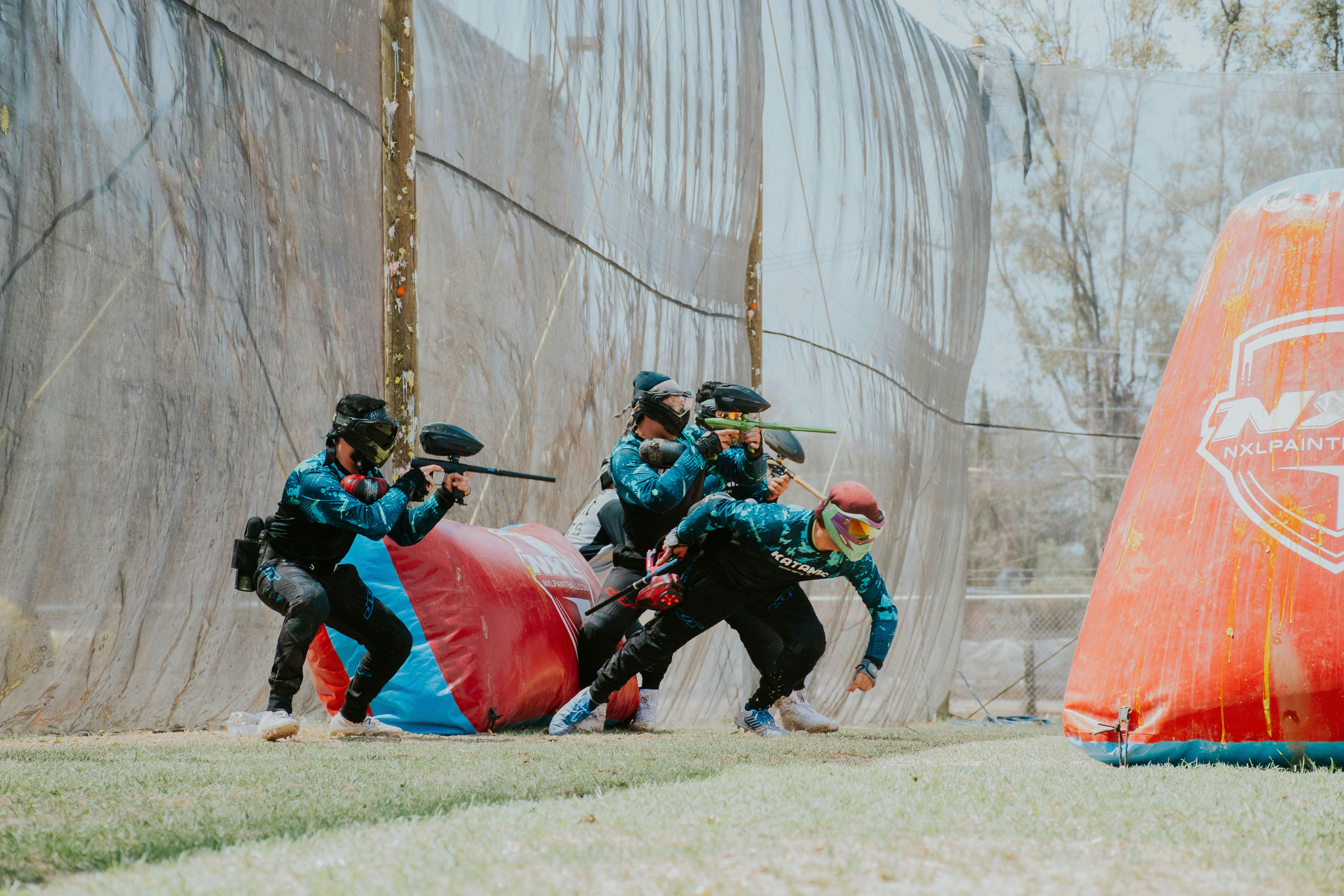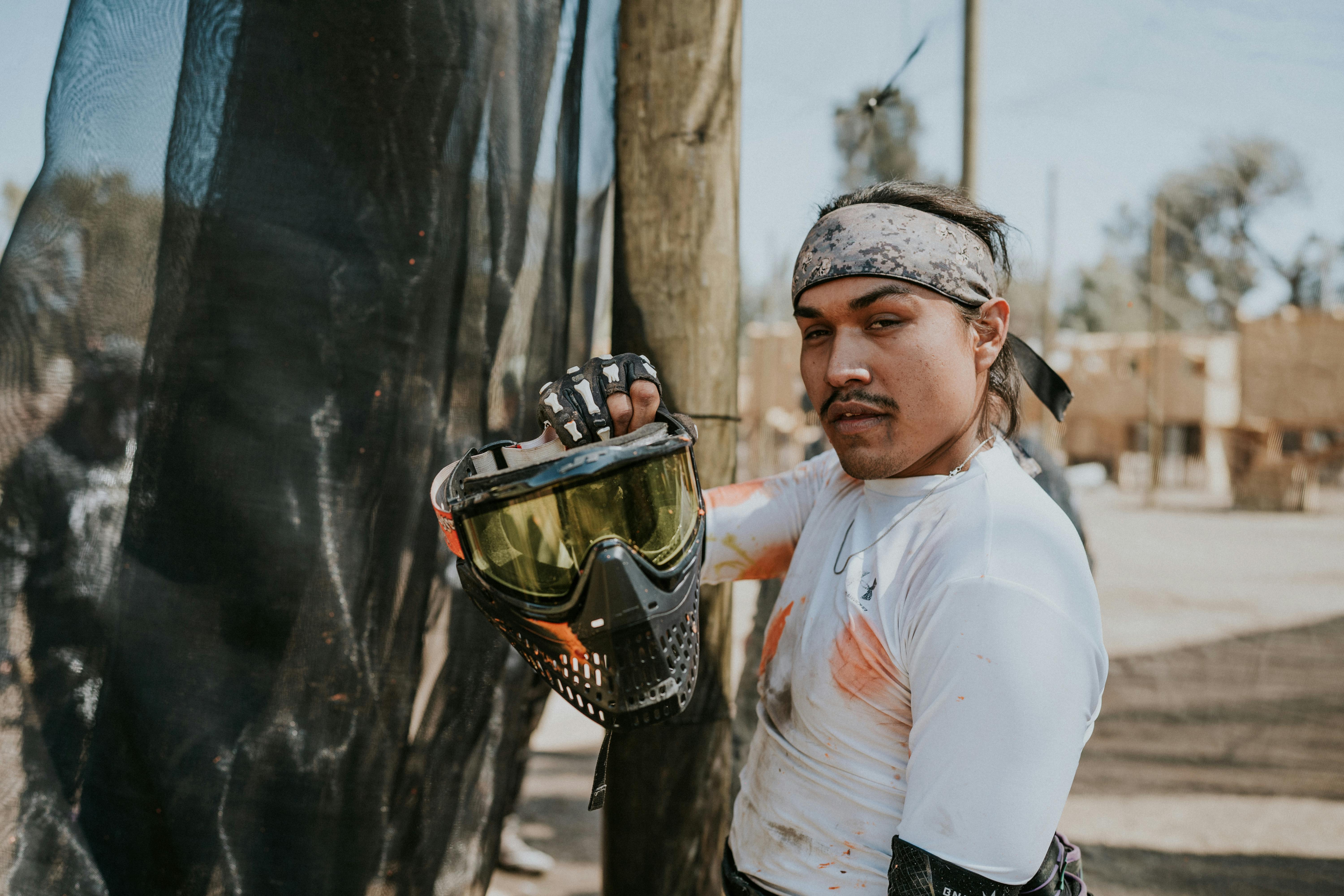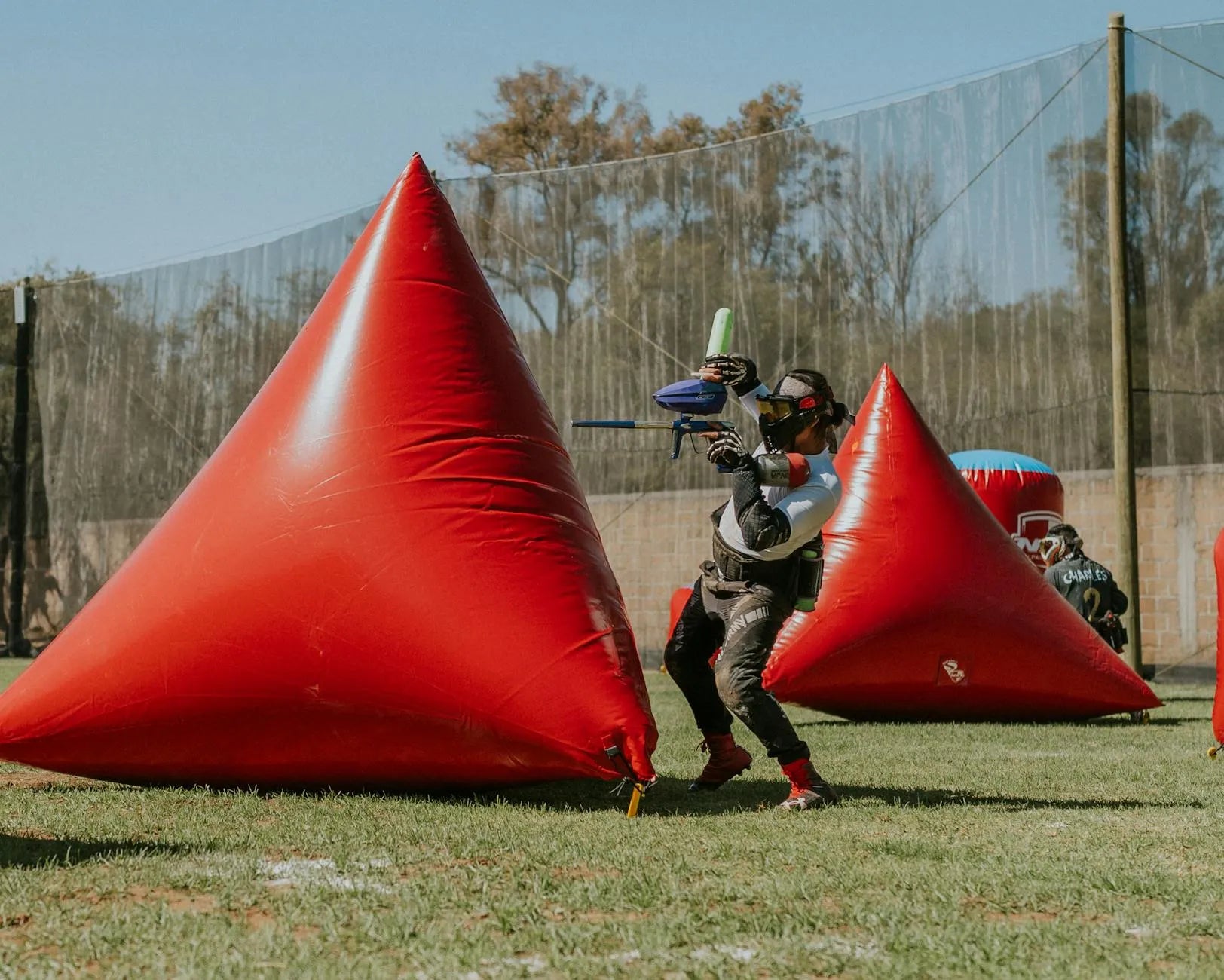5 Ways to Beat Winter Paintball Fog in 2025
Hey everyone, Lucas Hayes here. Winter paintball brings unique challenges. The crisp air, the crunch of snow underfoot – it’s exhilarating. But one issue plagues us all: mask fog. Nothing ruins a game faster than losing your vision. It's frustrating, blinding, and frankly, dangerous. I learned this the hard way more than once. Let's tackle how to maintain clear vision when the temperature drops.
Understanding the Fog Monster
Why Your Mask Fogs in the Cold
Fog happens because of simple physics. Your face and breath are warm and humid. The outside air and your mask lens are cold. This temperature difference causes moisture to condense on the inner lens surface. Think of a cold drink sweating on a warm day. It's the same principle, just inside your essential safety gear.
- Temperature Gap: The bigger the cold difference, the faster fog forms.
- Humidity Inside: Heavy breathing and sweat pump moisture into the mask.
- Poor Airflow: Trapped warm, moist air can't escape easily.
I remember games where my vision vanished mid-sprint. It felt like playing blindfolded. That frustration drove me to figure this out. We need reliable ways to combat condensation.

Battling the Blur: Common Anti-Fog Tactics
Sprays, Wipes, and DIY Attempts
Many players try topical anti-fog solutions. Sprays and wipes apply a thin coating. This coating helps moisture spread evenly. It becomes a thin film instead of view-blocking droplets. Some folks even try homemade remedies.
- Effectiveness Varies: These can work, but often need frequent reapplication.
- Cold Challenges: Winter cold and moisture test these coatings severely. Reapplying with cold hands isn't fun.
- Cost Factor: Sprays are cheap initially, but costs add up.
| Method | How it Works | Pros | Cons (Winter Specific) | Typical Cost (Approx) |
|---|---|---|---|---|
| Anti-Fog Spray | Hydrophilic coating spreads water | Easy application, readily available | Short duration, needs frequent reapplication | $6 - $10 per bottle |
| Anti-Fog Wipes | Pre-moistened coating application | Convenient single-use | Can be costly per use, duration varies | $0.95 - $17 (pack) |
| Dish Soap/Shamp | Surfactant action reduces tension | Very cheap, uses household items | Messy, potential residue, effectiveness hit/miss | Pennies |
| Spit | Enzymes/surfactants break tension | Free, always available | Unhygienic, least effective, temporary | Free |
I've tried them all. Sprays sometimes felt like a brief truce, not a victory. Wipes were convenient but often gone too soon. The DIY stuff? Let's just say results were... memorable, not always good. One time, dish soap residue made incoming paint look like abstract art. Not helpful when aiming.

The Thermal Lens Advantage
Investing in Clearer Sight
The most recommended upgrade for fogging is a thermal lens. This is a dual-pane system. Two lenses are sealed together with an air gap. This gap acts like insulation. It keeps the inner lens closer to your face temperature. This dramatically reduces condensation potential.
- Mechanism: Insulating air gap minimizes temperature differential on the inner lens.
- Performance: Significantly better fog resistance than single panes. It's the industry standard for a reason.
Think of it like double-glazed windows for your house. They prevent condensation effectively. A thermal lens does the same for your mask. It's a fundamental change in how the mask handles temperature differences.
Is the Higher Cost Justified?
Thermal masks and lenses cost more. That's undeniable. Budget single-pane masks are under $50. Good thermal options often start around $50-$100. High-end models can exceed $150 or $200. Replacement thermal lenses are also pricier, maybe $30-$60+.
- Initial Investment: Higher upfront cost for mask or lens.
- Long-Term Value: Saves frustration, improves safety, enhances game experience.
- Reliability: Far more dependable fog prevention, especially in cold/humidity.
| Feature | Single Pane Lens | Thermal (Dual Pane) Lens |
|---|---|---|
| Construction | One solid lens piece | Two lenses, air gap |
| Fog Resistance | Low (prone to fogging) | High (very resistant) |
| Cost | Lower ($20-$50 mask) | Higher ($50-$200+ mask) |
| Best Use | Warm/dry conditions | All conditions, esp. cold |
For years, I resisted the cost. I thought skill could overcome gear limitations. Then came the Pacific Rim Championships in 2021. The coastal humidity combined with exertion was brutal. My glasses fogged inside my single-pane mask. I couldn't see the flank attack. We lost the match. My fogged vision also caused a bad fall. That failure taught me clear vision isn't a luxury. It’s fundamental. A thermal lens became non-negotiable after that.

The Prescription Player's Nightmare
When Glasses Join the Fog Party
Playing paintball with prescription glasses adds another layer of complexity. Now you have two surfaces prone to fogging. Your glasses fog up from face heat. Your mask lens fogs up from the cold outside. It's double trouble. This was my reality for a long time.
- Double Fogging: Glasses fog inside, mask fogs outside/inside.
- Discomfort: Glasses frames press under the mask. It can be painful.
- Risk: Glasses could break on impact, risking eye injury.
I recall the constant adjustments. Trying to seat the mask over my glasses. Feeling the pressure points build. Worrying about a direct hit shattering a lens. It detracts significantly from the game. You're fighting your gear, not just opponents.
Failed Solutions: Contacts and Compromises
Many suggest contact lenses. I tried them. The intense airflow in paintball, especially cold winter wind, dried them out rapidly. My eyes felt gritty and irritated. Stinging became a constant companion. It felt like trading one problem for another.
- Dry Eyes: Cold wind exacerbates contact lens dryness.
- Irritation: Stinging, gritty feeling is distracting and uncomfortable.
- Hassle: Managing contacts at the field isn't always easy.
It seemed like a dead end. Glasses fogged or broke. Contacts became painful irritants. Was clear, comfortable vision impossible for prescription wearers? I started looking for dedicated solutions. Something designed for this specific problem. That's when I discovered goggle inserts. The concept was promising: prescription lenses held securely inside the goggle space.

Finding the Right Vision Solution
The Quest for Reliable Inserts
My past experiences shaped my criteria. I needed more than just lenses. I needed a system that worked reliably under pressure. The Pacific Rim failure haunted me. Any solution had to address those specific failure points. Clear vision couldn't be conditional. It had to be constant.
- Stability: The insert must stay put during intense movement. No shifting.
- Anti-Fog: Excellent fog resistance is paramount. No compromises here.
- Clarity: Optical quality must be high. No distortions.
- Durability: Materials need to withstand impacts and temperature changes.
- Fit & Comfort: Must integrate seamlessly with goggles without pressure points.
I looked at various options. Some seemed flimsy. Others had limited prescription ranges. Compatibility with popular goggles was a concern. Then I found Overo Glasses. Their approach seemed different. They focused on the details that mattered. The things that failed me before.
Overo: Designed for Demanding Conditions
The Overo Prescription Goggle Inserts caught my attention. They seemed engineered by people who understood the challenges. The frame material is Polycarbonate (PC). It’s known for toughness, even in extreme cold or heat. That addressed my durability concern. The lenses use CR39 material. It offers great optical clarity and includes UV resistance.
- Tough Frame: PC material for durability in all temperatures.
- Quality Lenses: CR39 for clarity and UV protection.
- Advanced Anti-Fog: A specific coating designed for clarity in humidity and cold.
What truly set them apart was the design thinking. They offer superior compatibility. They fit a wide prescription range. The universal interface works with major brands like Oakley, Smith, and Giro. Crucially, the frame height is adjustable. This allows a customized fit for different face shapes and goggle models. This adjustability tackles the comfort and stability issue directly.
- Universal Fit: Compatible with leading goggle brands.
- Adjustable Height: Customizable fit for comfort and stability.
- Wide Prescription Range: Accommodates many vision needs.
Users consistently report what I desperately needed: clear vision. They mention minimal fogging, even in tough weather. The stable fit eliminates the hassle of glasses shifting. The adjustable design provides real comfort. For $119.99, the value seemed excellent compared to competitors. Some alternatives are pricier, offer fewer options, or lack adjustability. Overo felt like the complete package. It addressed the failures I experienced. It promised the reliable vision I needed to compete safely.
Winter Mask Care Essentials
Keeping Your Lens Crystal Clear
Maintaining your mask lens is crucial, especially in winter. Dirt and scratches worsen fogging. Improper cleaning damages expensive thermal lenses or anti-fog coatings. Winter play adds challenges like snow, slush, and frozen paint. Proper care protects your investment and your vision.
- Clean Promptly: Don't let paint or mud dry hard, especially in freezing temps.
- Use Right Materials: Microfiber cloths are mandatory. Avoid abrasive materials.
- Avoid Harmful Chemicals: Stick to water or approved lens cleaners.
Here’s a simple cleaning routine:
- Remove Lens (If Possible): Follow manufacturer instructions carefully.
- Use Microfiber ONLY: Gently wipe outer lens. Use water or lens cleaner sparingly if needed.
- Inner Lens Care (Thermal): Use a dry microfiber. Dab gently if absolutely necessary. NEVER get moisture between thermal panes.
- Air Dry Completely: Do not store damp. Use a protective goggle bag.
Never submerge a thermal lens. Trapped moisture ruins the seal permanently. Scratches impair vision and give fog condensation points. Treat your lens carefully. It's your window to the game.

On-Field Fog Emergencies
Quick Actions When Vision Blurs
Even with preparation, fog can strike unexpectedly. Maybe you sprinted hard, or your mask shifted. Knowing safe, immediate actions is vital. Panic is your enemy when vision clouds over. Remember the golden rule first.
- Safety First: NEVER, EVER REMOVE YOUR MASK ON THE FIELD. Eye injuries are devastating and almost always happen when protection is off. Statistics confirm this starkly. Ruptured globes, detached retinas, blindness – these are real risks. Don't become a statistic.
If fog starts creeping in mid-game:
- Control Your Breathing: Try breathing slowly, downwards out of your mouth. Direct moist air away from the lens. Avoid panting up into the mask.
- Check Vents: Ensure clothing (hoodie edge, beanie) isn't blocking ventilation ports. Clear any debris if possible without removing the mask.
- Minor Adjustment (CAUTION): Briefly, carefully lifting the bottom edge slightly might help vent air. This is risky. Know your field rules. Prioritize safety.
- Do NOT Wipe Inside: Smearing moisture makes it worse. It can also damage anti-fog coatings. Resist the urge.
If vision becomes dangerously impaired:
- Call Yourself Out: Signal you are hit or unable to continue safely.
- Retreat Safely: Move to the deadbox or staging area. Address the fog properly off-field. Your safety is paramount.
Playing effectively means playing safely. That requires clear vision. Learning these quick responses helps manage unexpected fog. But prevention remains the best strategy.

Final Thoughts: Prioritizing Vision
Winter paintball is incredibly rewarding. The intensity is heightened by the elements. But impaired vision turns fun into frustration. It turns sport into a hazard. My journey from childhood disinterest to professional play was marked by vision struggles. The Pacific Rim failure was a harsh lesson. It fueled my advocacy through the #ClearVisionCampaign. Clear sight isn't just about performance. It's fundamental to safety and enjoyment.
- Gear Check: Before winter games, assess your mask situation.
- Invest Wisely: Consider thermal lenses or quality inserts like Overo if fog persists. Especially if you wear glasses.
- Maintain Diligently: Proper cleaning preserves lens performance.
Don't let fog dictate your paintball experience. Take steps to ensure clear vision. Embrace the challenge of winter play with confidence. See clearly, play safely, and enjoy the game. Gravity might win sometimes – falling is just getting to know the earth better. But fog shouldn't take you out of the fight.
Frequently Asked Questions
Why does my paintball mask fog up in winter?
Fog occurs due to temperature differences between your warm breath and face against the cold air and mask lens. This creates condensation on the inner lens surface, similar to a cold drink sweating on a warm day.
What is the most effective solution to prevent mask fogging?
The most effective solution is investing in a thermal lens. Thermal lenses have a dual-pane design with an insulating air gap that minimizes fogging, offering better resistance than single-pane lenses.
Are anti-fog sprays or wipes worth using?
Anti-fog sprays and wipes can help temporarily but often require frequent reapplication, especially in colder conditions. They're affordable but may not be reliable during intense winter games.
Can players with prescription glasses play without fog issues?
Yes, using prescription goggle inserts like Overo can help. These inserts are designed to prevent fogging issues and fit securely inside your mask, eliminating problems associated with traditional glasses or contacts.
How do I properly clean and maintain my mask during winter?
Use a microfiber cloth to clean your mask, avoid submerging thermal lenses in water, and ensure full drying before storing. Proper care prevents scratches and damages that worsen fogging.
What should I do if my mask fogs up mid-game?
Try breathing slowly downward, ensure vents are clear, and avoid wiping the inside of the lens. If vision becomes unsafe, call yourself out and retreat to address the fog in a secure area.
References
- High Stakes Paintball Instagram - Highlights from winter paintball games and gear insights.
- Battle Creek Paintball Blog - Comprehensive blog posts on paintball tips and techniques.
- Mechanix Winter Work Gloves - Protective gloves suitable for cold-weather paintball games.
- Facefull Paintball Instagram Post - Winter paintball tips and game nostalgia.
- Mechanix Insulated Gloves - Winter-specific insulated gloves to keep hands warm during games.



Share:
5 Top Paintball Goggle Brands for Rx Inserts
Top 3 Reasons Contact Lenses Fail Paintball Players 2025